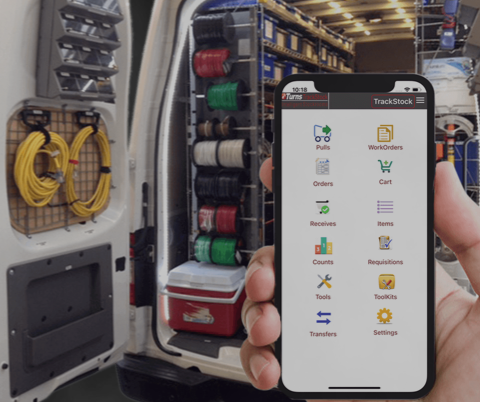Exclusive: 6 Key Inventory Metrics for Electrical Contractor Service Truck Fleets
Improve inventory tracking and stock levels, increase technician efficiency and enhance customer satisfaction.
By Rock Rockwell, CEO, eTurns
 Managing inventory and technician productivity can be difficult for contractors and supervisors in charge of service truck fleets. Without the right tools, you could be overlooking vital performance indicators and losing money. Knowing how well your service-truck inventory is doing across several key metrics will enable you to lower carrying costs and pinpoint areas that need improvement.
Managing inventory and technician productivity can be difficult for contractors and supervisors in charge of service truck fleets. Without the right tools, you could be overlooking vital performance indicators and losing money. Knowing how well your service-truck inventory is doing across several key metrics will enable you to lower carrying costs and pinpoint areas that need improvement.
Tracking performance metrics in various areas of your fleet is an important first step in improving operations. By monitoring the response time, number of trips to supply stores, and job completion percentage of your fleet, you can see whether technicians are productive, have the supplies they need and can respond quickly to customer requests.
By monitoring key inventory metrics, contractors can:
- Optimize inventory levels by comparing inventory volume and accuracy to historical data
- Ensure ongoing inventory reporting accuracy
- Identify areas for improvement
- Enable technicians to be more timely and productive
- Benchmark performance metrics against industry standards
 Manually tracking inventory and technician productivity can be challenging. But without knowing what is happening at the ground level, you could be overstocking the wrong inventory and understocking the right parts. With the right system in place, you can avoid costly problems, including:
Manually tracking inventory and technician productivity can be challenging. But without knowing what is happening at the ground level, you could be overstocking the wrong inventory and understocking the right parts. With the right system in place, you can avoid costly problems, including:
- Overstocking – Over-purchasing inventory results in high carrying costs for slow-moving products, and a negative impact on your cash flow. Extra bulk also fills up space in service trucks and makes it difficult for technicians to find the parts they need.
- Inefficiency – Well-stocked and optimized inventory in your service trucks means your technicians will always have what they need on hand without having to make multiple trips to the store. And kitting of commonly used parts for specific tasks can improve a technician’s efficiency.
- Lack of visibility – Without inventory usage visibility, you could face regular stockouts and accounting inaccuracies.
- Customer dissatisfaction – When a technician has to stop working in the middle of a project to go to the store and buy a part, operating costs rise, and customer satisfaction diminishes. A lack of preparation often leads to unhappy customers, lost business, reduced profits, and a poor reputation.
6 Inventory Metrics to Monitor
Contractors and their suppliers often focus on the wrong metrics. For instance, relying on historical sales figures to determine when parts need replenishing often leads to overstocking, increased carrying costs and poorly managed space in service trucks. Because demand varies from day to day, it is vital to monitor real-time usage rather than depend on past sales to determine stocking levels.
When deciding which Key Performance Indicators (KPIs) will be most beneficial to track, consider which metrics will help you improve your business, achieve your strategic objectives and improve customer satisfaction. The right metrics can also help you benchmark your organization against competitors.
Monitor these six KPIs:
- Inventory Accuracy – Are the on-hand quantities of the items in your service trucks correct? Or will the technician regularly find themselves without the right parts for the job?
- Inventory Turnover – How often is the inventory used on each truck? Are there parts your technicians never use?
- Inventory Valuation – What is the value and quantity of each truck’s inventory? Could this number be lowered?
- Carrying Costs – What is the annual carrying cost of the truck inventory?
- Out-of-Stock Rate – How often do technicians find that they do not have all the parts needed on their truck?
- Shrinkage – Do you track shrinkage? Can you track shrinkage? Having the ability to quickly count current on hand quantities for each item on a truck and compare it to what is supposed to be on each truck will quickly identify what inventory has “walked off” a truck.
How Can Technology Help?
Manually tracking KPIs is time-consuming and prone to errors. Thankfully, technology exists that can optimize replenishment and provide real-time visibility into your service trucks. For example, inventory management apps enable you to create work orders, capture before and after photos of the job and capture the client’s signature to validate the parts and labor used. Work orders track usage of parts and labor to help with recording costs and usage. Customers can be invoiced more accurately. Parts usage off the trucks is properly tracked, thereby monitoring and reducing shrinkage.
An app that tracks usage on jobs can also calculate optimized minimums and maximums to properly stock a service truck. Optimized minimums and maximums will reduce cash sitting on the truck, which prevents stockouts. Stockouts cause the technician to leave a jobsite to go to a supplier to replenish. An app that optimizes inventory levels eliminates all this wasted effort, while providing maximum customer value and service. The right technology will improve accuracy, productivity, and customer satisfaction while boosting profit margins. CS
Rock Rockwell is CEO of eTurns, a point of use inventory management app that automates inventory replenishment in stockroom and service trucks using phones, RFID and TrackStock SensorBins™. Contact Rockwell at rock@eturns.com.
















